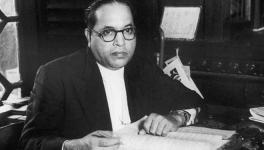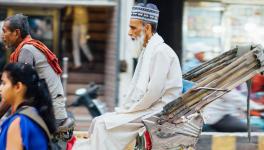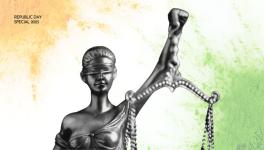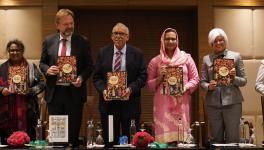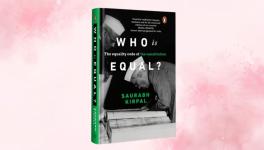The Dravidian Remedy To The Inequities of Hindutva

Last year, the Chief Minister of Tamil Nadu M.K. Stalin stated that the Dravidian welfare model of governance should not be limited to Tamil Nadu alone. He insisted that it should be a guiding light for all states in India. According to him, if the principles of the Dravidian model spread across India, the entire country will prosper. Stalin further stated that if communalism, religious fundamentalism and autocratic tendency are allowed to rear their heads on the contrary, they would not add to the glory of India.
Stalin launched the All India Federation for Social Justice (AIFSJ) with an aim to “unite like-minded leaders, political parties, social activists, organisations and civil society organisations on a common platform to fight for social justice across the nation.”
On April 3, the AIFSJ held its first National Conference that was attended and addressed by key opposition leaders and civil society members including Akhilesh Yadav (Parliamentarian and President, Samajwadi Party), Farooq Abdullah (Parliamentarian and President, Jammu & Kashmir National Conference), Derek O’Brien (Parliamentarian and All India Trinamool Congress member), Chhagan Chandrakant Bhujbal (Maharashtra legislator and Nationalist Congress Party member), Sanjay Singh (Parliamentarian and Aam Aadmi Party member), K. Veeramani (President, Dravida Kazhagam (DK)), Vaiko (Parliamentarian and General Secretary, Marumalarchi Dravida Munnetra Kazhagam), Prof. M.H. Jawahirullah (Parliamentarian and President, Manithaneya Makkal Katchi), Thol. Thirumavalan (Parliamentarian and President, Viduthalai Chiruthaigal Katchi), E.R Eswaran (Tamil Nadu legislator and General Secretary, Kongunadu Makkal Desia Katchi), Ashok Gehlot (Chief Minister of Rajasthan and Indian National Congress member), Hemant Soren (Chief Minister of Jharkhand and President, Jharkhand Mukti Morcha), Tejashwi Yadav (Deputy Chief Minister of Bihar and Chairperson, Rashtriya Janata Dal (RJD)), Sitaram Yechury (General Secretary, Communist Party of India (Marxist)) D. Raja (General Secretary, Communist Party of India), Mahadev Jankar (Maharashtra legislator and President, Rashtriya Samaj Paksha), Naba Kumar Sarania (Parliamentarian and President, Gana Suraksha Party), Rajkumar Saini (former Parliamentarian and President, Loktantra Suraksha Party, Haryana), Prof. Manoj Kumar Jha (Parliamentarian and National Spokesperson, RJD), E.T. Muhammad Basheer (Parliamentarian and Organising Secretary, Indian Union Muslim League), K. Keshava Rao (Parliamentarian and Parliamentary Party Leader, Bharat Rashtra Samithi), P. Wilson (Parliamentarian and DMK member), journalist and author Dilip Mandal, B.N. Wagh (National Convenor, Phule Ambedkari Gauravshali Aur Adarshawadi Muhim), political analyst Dr Anil Jaihind, Bahadur Singh Lodi (Chief Organiser, Pichhda Varg Sanyukt Sangharsh Morcha), Waman Meshram (National President, All India Backward and Minority Communities Employees Federation), B.D. Borkar (former President of People’s Party of India (Democratic)), Delhi University professors Prof. Laxman Yadav, Prof. Suraj Mandal and Prof. Ratan Lal, Justice (Retd.) V. Eswaraiah, and Justice (Retd.) Virendra Singh. The platform brought all of them together for the common ideology of social justice.
Stalin delivered the presidential address in which he spoke about the Tamil Nadu model of Dravidian welfare governance. This was an interesting proposition and initiative by Stalin, where he appeared to suggest a counternarrative of developmental and welfare politics as an opposition ideology to that of the Bharatiya Janata Party (BJP)–Rashtriya Swayamsevak Sangh (RSS)’s dominant right-wing–uppercaste ideology.
Under the circumstances, the present socio-political scenario and the upcoming 2024 Lok Sabha elections in India have become a crucial opportunity for the opposition parties to unite under one umbrella.
Stalin appeared to suggest a counter narrative of developmental and welfare politics as an opposition ideology to that of the BJP–RSS’s dominant right wing-upper caste ideology.
However, unification alone is not enough to defeat the brutal majority of the BJP. The opposition parties need a strong binding force to cement them together and put forth an alternative narrative through an unshaken and solid, strong ideology that would serve as an antithesis to the powerful ideological base of the RSS-led BJP. It is, therefore, imperative for us to revisit the pages of southern Indian political history to understand the ideology of the Dravidian welfare model of governance.
Also read: Reimagining a justice and legal system which actively eliminates hierarchies
Coalition of rivalries
Politician and Dravidian activist Taravath Madhavan Nair served as the councillor of Triplicane in the Madras Corporation from 1904 to 1916. During his tenure, he was at loggerheads with another senior member and the then President of the Madras Corporation, lawyer, industrialist and political leader Sir Pitti Theagaraya Chetty.
The rivalry started when Chetty used municipal water to fill the Triplicane water tank and Nair stopped these efforts, terming them to be a waste of public resources. Their bitterness continued to grow over and around the water tank. Nair was of the view that people should be stopped from washing clothes in the tank and the residents be taxed for its maintenance. Chetty was against this and called for a vote in the corporation, in which he defeated Nair.
In 1916, Nair was defeated by politician, administrator, educator, orator and independence activist V.S. Srinivasa Sastri in the elections to the Imperial Legislative Council; in the same year, Chetty also faced defeat in the local council elections. The common factor in their defeat was that both lost to Brahmin candidates. Despite the lingering animosity, their losses prompted Nair and Chetty to rethink their antagonistic stance towards each other.
Politician and Dravidian activist Dr C. Natesa Mudaliar seized the opportunity and facilitated a peace treaty between the two for a greater cause, that is, to join hands against Brahmin hegemony, and ensure representation of non-brahmins in spheres of power and in the processes of decision-making.
On November 20, 1916, within the walls of the Victoria Public Hall in Madras, thirty people, including Nair, Chetty, Dr Mudaliar, the zamindar of Kalahasti Sir Raja Panaganti Ramarayaningar, and female politician Alamelu Mangai Thayarammal formed the South Indian Liberation Foundation, popularly known as the ‘Justice Party’.
Non-Brahmin manifesto
On December 20, 1916, Chetty proclaimed ‘The Non-Brahmin Manifesto’, a concise yet powerful document which outlined the brutal domination of Brahmins in the fields of education and employment. The document, through official statistical data, showed how non-Brahmins were severely under-represented in the public sphere, and outlined the immediate need for them to unite under one roof for their own emancipation.
Because of its simple language and straightforward and factual tone, the Non-Brahmin Manifesto reached every nook and corner of what was then the Madras Presidency, and created a much-needed uproar amongst the non-Brahmins. It became the tool through which people from various walks of life came together to seek their rightful share in the public domain.
The Justice Party implemented several radical schemes, including voting rights for women for the first time in India, passing of the so-called Communal Government Order that introduced reservation on the basis of caste, introducing the noon meal scheme, and encouraging children from the lower strata of the society to continue their education
Due to this, the Justice Party won four out of the five elections it contested in and implemented several radical schemes, including voting rights for women for the first time in the Indian sub-continent, passing of the so-called Communal Government Order that introduced reservation on the basis of caste, introducing the noon meal scheme, and encouraging children from the lower strata of the society to pursue education.
The impact of these schemes gradually increased the proportion of posts held by non-Brahmins and came as a direct blow in the face of the Brahmin hegemony that dominated the Madras Presidency. Tamil politician C.N. Annadurai, the first Chief Minister of the DMK (the current successor of the Justice Party), said in the state legislative assembly that the Justice Party was the seed of the Dravidian movement that was sowed deep in the soils of Tamil Nadu.
Also read: Erosion of Constitutional Rights and Growing Anti-caste Movements
Justice Party and the Indian Constitution
The Justice Party, on September 16, 1921, issued a Governmental Order which enabled non-Brahmin, Muslim, Christian and Adi-Dravidar communities to get adequate representation in government jobs. The ‘Communal GO’, as it is popularly known, introduced the legal concept of affirmative action for the first time in India.
The law was in force for 29 years until it was struck down as ultra vires to the Constitution by the Supreme Court in the case of The State of Madras versus Srimathi Champakam (1951). The Supreme Court held that reservation in public institutions for backward classes violated Article 15(1) of the Constitution.
This marked the beginning of a series of protests in Tamil Nadu led by social activist and politician Erode Venkatappa Ramaswamy, popularly known as Thanthai Periyar. The success of these protests forced the Union government to enact the Constitution (First Amendment) Act, 1951 and insert Article 15(4) into the Constitution. This amendment nullified the Supreme Court’s verdict and enabled the State to make special provisions for socially and educationally backward classes.
Consequently, the Socially and Educationally Backward Classes Commission, set up by the Union government in 1979 (popularly known as the Mandal Commission, after its head, politician B.P. Mandal), and its socially relevant findings can be attributed to the enactment of this amendment, the roots of which can be traced back to the initial paragraphs of the Non-Brahmin Manifesto, which states that:
“Not less than 40 out of 41 percent millions (sic), who form the population of this presidency, are non-Brahmins, and the bulk of the taxpayers, including a large majority of the zamindars, landholders and agriculturists, also belong to the same class. But in what passes for politics in Madras they have not taken the part to which they are entitled. They make little or no use of their influence among the masses for the general advancement of the country, in these days of organised effort, they maintain no advancement of the country.”
Also read: From the vault: Contemporary challenges before the anti-caste movement
Dravidian model of governance— an evolution of the Justice Party
The foundation of Tamil Nadu’s socio-political infrastructure has been laid on the ideals of the Justice Party. The Dravidian Model of Governance, as it is popularly called, prioritises social justice, equality, economic development, and women’s rights, among others. Successive governments in Tamil Nadu more or less walked on the path paved by the Justice Party and ensured their founding principles are reflected in the schemes introduced by them.
The foundation of Tamil Nadu’s socio-political infrastructure has been laid on the ideals of the Justice Party. The Dravidian Model of Governance, as it is popularly called, prioritises social justice, equality, economic development, and women’s rights.
The cumulative results of rolling out such schemes resulted in a gradual and consistent improvement in the social indices of the state. Ensuring social justice in education and equality in opportunities has pushed the gross enrolment ratio of Tamil Nadu to 52 percent.
The density of doctors, that is, the number of doctors per 1,000 people is four in Tamil Nadu, which is almost equal to the numbers in developed countries like Norway and Sweden. According to the Union government, Tamil Nadu falls in the Tier-1 category of states that have achieved high progress in the Social Progress Index for States and Districts prepared by the Institute for Competitiveness and Social Progress Imperative.
The social diversity of the judges in the High Court of Madras is also among the highest in the country, with 58 judges belonging to the Other Backward Classes (OBC)/Scheduled Castes (SC)/Scheduled Tribes (ST)/minority communities appointed only in the last five years (the high court’s total bench strength is 57). The state is also known to have the highest number of working women in the country, who contribute to its Gross Development Product.
These, among various other achievements of the state, reflect the progress in economic development that has been achieved by Tamil Nadu so far. However, unfortunately, the politics of social justice has not adequately spread across the rest of India, which has created a large void in equal representation, rights for women, and economic development at large. These issues impact every person living in India and require attention.
Equal representation of disadvantaged caste groups in India continues to be a crucial yet distant ambition to be realised.
Disproportionate representation, a continuing scheme in the national scene
The social, political and legal history of India carries with itself a baggage of non-inclusivity and social exclusion. Therefore, adequate representation to all people in India can be ensured only through reserving seats for their respective groups, proportional to the numerical space they represent within its geopolitical landscape.
Hence, political parties have been demanding a caste-based census in order to identify the percentage of caste-based population in our country, as we have been relying on old and outdated data to determine their share of the population.
The last published caste census of the OBCs dates to 1931, according to which 52 percent of the country’s population comprised the OBCs. Whereas, the SCs and STs hold around 16.6 percent and 8.6 percent of the country’s population respectively as per the 2011 census. Yet, the general category, which is essentially a tiny group that consists of the forward castes who are socially and educationally more advanced than the rest of the population, continue to hold most of the positions of power and dominate with their representation in all spheres.
Also read: The devil is in the detail: need for contemporaneous caste census in India
Government data from the past five years shows a severe case of under-representation of the OBCs, SCs and STs as compared to the so-called forward communities across sectors. For instance, the five-year figures of the direct recruitment for the All India Services shows a total of 4,365 appointments made. Out of 15 percent posts reserved for SC candidates, only 7.65 percent appointments were made. Of the total 7.5 percent reserved posts for STs, only 3.8 percent appointments were made, and only 15.92 percent of the 27 percent reserved posts for OBCs were appointed. The reservation formula mandates a total of 49.5 percent posts for the OBCs, SCs and STs in the All India Services, whereas the five year data shows their appointment to only 27.37 percent of the posts. This is a daunting gap in the very social fabric of our country.
Government data from the past five years shows a severe case of under-representation of the OBCs, SCs and STs as compared to the so-called forward communities across sectors.
The domination of the upper castes in the higher judiciary has been a matter of concern and the five-year figures provide for uneven numbers in the 25 high courts across our country. The data shows that the majority of the appointments in the high courts are made in favour of the forward communities, whereas the OBCs, the SCs and the STs continue to be under-represented. Since 2018, of the 537 judges appointed to the high courts, a staggering 79 percent were from the upper castes and only 11 percent belonged to the OBCs. The representation of the SCs and STs was drastically low at 2.8 percent and 1.3 percent each.
The representation scenario of the OBCs in Public Sector Undertakings is also poor. The recent numbers show that the executive board of directors at PSUs such as the Bharat Sanchar Nigam Limited, the Airport Authority of India, the Gas Authority of India Limited, and the Canara Bank, among others, have zero representation from OBC communities.
Despite a year-long recruitment drive, from September 2021 till September 2022, 45 Central universities across the country were able to fill up only 449 of the 1,439 identified faculty vacancies reserved for the OBCs, SCs and STs— 18 of these 45 Central universities failed to recruit anyone from these three categories despite having vacancies for the same and these posts remain vacant.
The recruitment drive in the Indian Institutes of Technology (IITs) also showed minimal output as only 237 reserved faculty vacancies were filled out of 342 identified vacancies at 19 IITs. Even in these recruitments, vacancies for the posts of professor and associate professor were not filled by any OBC, SC or ST candidate. Regarding this disparity in the appointments of faculty members, the Supreme Court had ordered the IITs “to follow the reservation and act as per the reservations provided under the Central Educational Institutions (Reservation in Teachers’ Cadre) Act, 2019.”
As a recent development, the scholarships given to OBC students in schools have also been reduced drastically. A pre-matric scholarship was given to OBC students studying at government, government-aided and private schools from classes I to X. Now, the scholarship has been revised by the Union Social Justice and Empowerment Ministry, and has been limited to only OBC students studying in Classes IX and X at government schools. As has been concluded by several scholars, including G. Karunanidhy, secretary of the All India OBC Employees Federation, the latest revision shall result in a lot of OBC students dropping out from school.
Also read: IIM Ahmedabad adamant to not implement ST, SC & OBC quota for 2020 admissions to Ph.D course
The OBC question
The BJP has recently launched a scathing attack on the Indian National Congress leader Rahul Gandhi, alleging that he has hurt the sentiments of OBC communities through his remarks on ‘Modis’. Quite obviously, the BJP is attempting to become a spokesperson for the OBC and oppressed communities.
However, existing data and facts as quoted above are only reflective of the larger issues of inadequate caste representation that are left unaddressed by the Union government in its governance of nearly nine years. The government has not given sufficient attention towards the development of the OBC communities which would showcase its true concern for the representation and dignity of the community.
The government has not given sufficient attention towards the development of the OBC communities which would showcase its true concern for the representation and dignity of the community.
Unfortunately, such occasional lip service to the causes and concerns of the OBCs is yet another tragic political rhetoric used by the BJP to prevent the public discourse from focussing on the real issues faced by the OBC community. A united opposition with a solid ideological base for equal representation should be able to counter these attacks and use it as a pivot to redirect the political discourse on the actual issues of representation and equality.
Also read: OBC Reservations: Investigating caste, backwardness and representation
Need for a rebirth: Time to revisit the political and social history of the Justice Party
India is at a juncture where there is an urgent need for the under-represented communities, including OBCs, SCs and STs, to unite under one roof to get their fair share of representation in the public domain. This socio-political climate of the country right now mirrors the scenario that existed in the Madras Presidency that gave birth to the Justice Party, which in turn produced the Non-Brahmin Manifesto. To borrow a few words from the document itself,
“Guided by their own sense of self-respect and enlightened self-interest, had they and their communities always acted in concert, even in the matter of government appointments and political power, they would have been at the top, a place which is theirs by right. As it is, for want of efficient separate organisations of their own and of the instinct or the inclination to make the freest and the most effective use of the modern weapon of publicity, their interests have not received their proper share of attention and recognition.”
Much like Nair and Chetty, who set aside their differences to form a collective front in the form of the Justice Party, the dismal state of non-Brahmin representation and equality in India should function as a catalyst for the opposition parties to unite despite their differences in order to protect and pursue the aspiration of adequate and equal representation of all communities in all appointments, and to preserve the spirit and thrust of the Constitution.
It is important to understand that a mere unification of the opposition parties is not adequate. The unification must happen upon the foundation of a strong and deep-rooted ideological narrative that runs contrary to equally deep-rooted right-wing, upper-caste-centric BJP–RSS ideology. The AIFSJ, in that sense, has the potential to play a crucial role in reflecting and disseminating the principles of the Justice Party, giving it a national platform for the larger goal of mirroring the spirit of Dravidian welfare politics.
The united opposition should equip itself with the principles laid down in the Non-Brahmin Manifesto, for it stands relevant even after over a hundred years of its publication. The manifesto minced no words when it declared that where an electorate is composed of a large number of privileged upper castes, the backward caste Indians shall be deprived of all opportunities.
When the opposition is able to come together as one united force with a common ideology for representation of the oppressed sections of the society, it must be able to lay the foundation of another similar Non-Brahmin Manifesto. This manifesto should reflect the Dravidian welfare model of politics which must spread to the whole of India, and uplift the OBC and all other bahujan communities through equal representation in all spheres.
Therefore, when the opposition is able to come together as one united force with a common ideology for representation of the oppressed sections of the society, it must be able to lay the foundation of another similar Non-Brahmin Manifesto. This manifesto, as contended by Stalin and the AIFSJ, should reflect the Dravidian welfare model of politics which must spread to the whole of India, and uplift the OBC and all other Bahujan communities through equal representation in all spheres.
Get the latest reports & analysis with people's perspective on Protests, movements & deep analytical videos, discussions of the current affairs in your Telegram app. Subscribe to NewsClick's Telegram channel & get Real-Time updates on stories, as they get published on our website.










